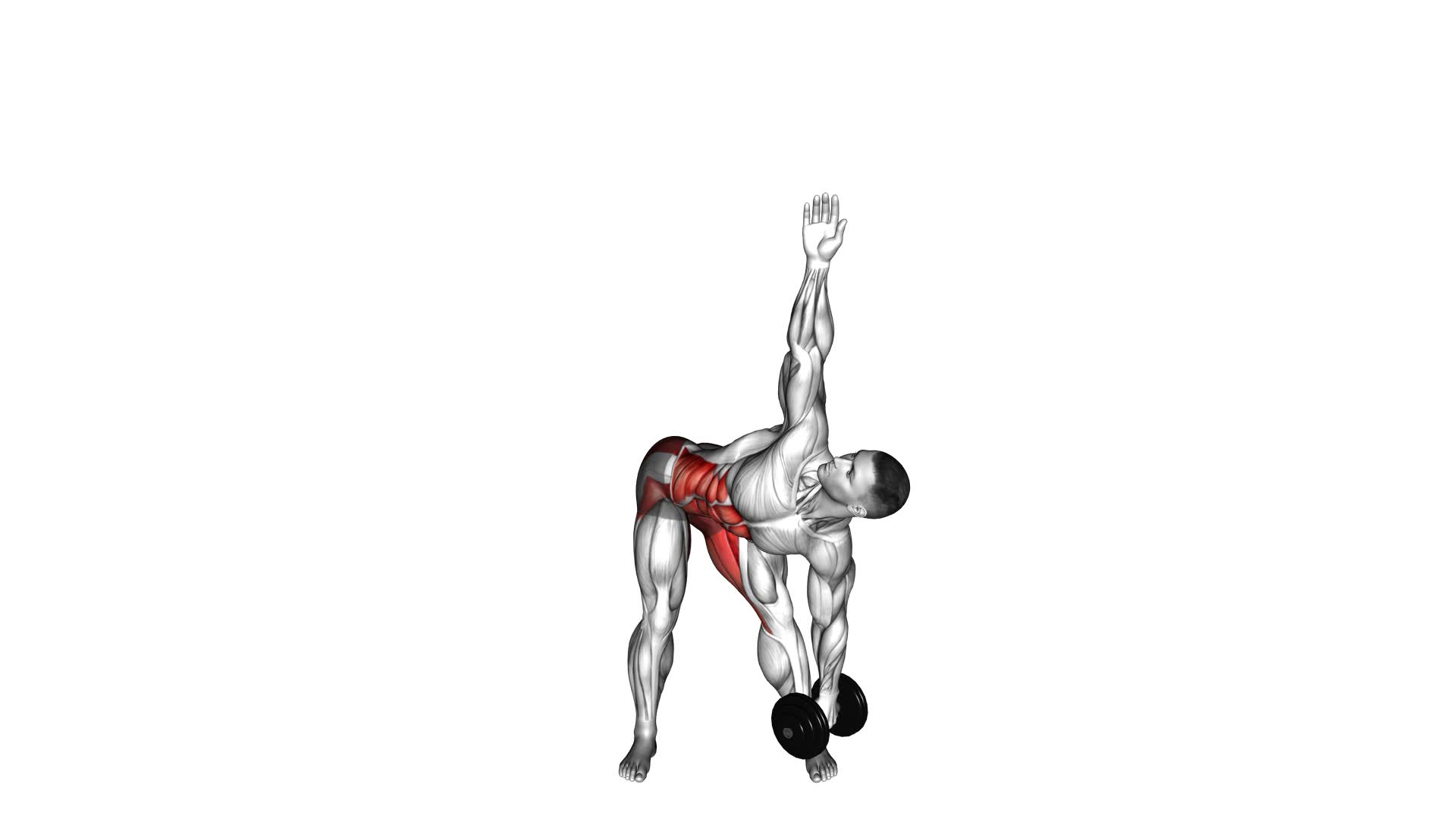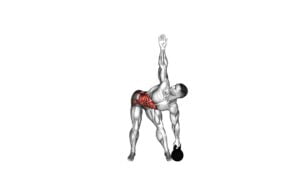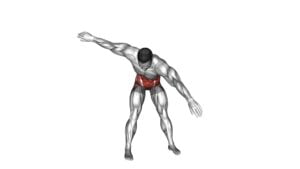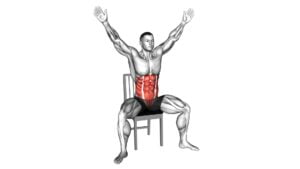Dumbbell Low Windmill – Video Exercise Guide & Tips

Get ready to tone your muscles and improve your flexibility with the Dumbbell Low Windmill exercise. In this video exercise guide, we'll show you the proper form and technique to maximize the benefits of this effective workout.
Watch This Exercise Video
Whether you're a beginner or looking for a challenge, we've got you covered with variations and modifications. Avoid common mistakes and get the most out of your workouts.
Let's dive in and start sculpting your body with the Dumbbell Low Windmill.
Key Takeaways
- Dumbbell Low Windmill engages multiple muscles in the abdominal region, including rectus abdominis, obliques, and transverse abdominis.
- It strengthens core muscles and enhances stability and balance.
- It improves shoulder mobility and flexibility, while reducing the risk of shoulder injuries.
- It enhances upper body performance in other exercises and daily activities.
Benefits of Dumbbell Low Windmill
Discover the incredible benefits of the Dumbbell Low Windmill for building core strength and improving flexibility.
This exercise is highly effective in improving core strength as it engages multiple muscles in the abdominal region, including the rectus abdominis, obliques, and transverse abdominis. As you perform the Dumbbell Low Windmill, your core muscles work together to stabilize your torso, allowing for a controlled and smooth movement. This not only strengthens your core, but also enhances your overall stability and balance.
In addition to core strength, the Dumbbell Low Windmill is also beneficial for increasing shoulder mobility. As you rotate your torso and reach towards the floor with the dumbbell, your shoulders undergo a full range of motion. This helps to improve the flexibility and mobility of the shoulder joints, reducing the risk of injuries and enhancing your upper body performance in other exercises and daily activities.
By incorporating the Dumbbell Low Windmill into your workout routine, you can experience significant improvements in both core strength and shoulder mobility. These benefits won't only enhance your ability to perform other exercises effectively, but also contribute to better posture and overall body stability.
Now, let's move on to the next section where we'll discuss the proper form and technique for performing the Dumbbell Low Windmill.
Proper Form and Technique
To perform the Dumbbell Low Windmill correctly, you should start in a standing position with a dumbbell in one hand.
Here are some important tips to ensure proper form and technique:
- Importance of core engagement: Before you begin the movement, engage your core muscles by drawing your belly button towards your spine. This will provide stability and support throughout the exercise.
- Breathing techniques during the exercise: Take a deep breath in as you start the movement and exhale as you lower the dumbbell towards the ground. This will help you maintain control and stability while also activating your core muscles.
- Maintain a neutral spine: Throughout the exercise, it's crucial to keep your spine in a neutral position. Avoid rounding or arching your back, as this can lead to injury. Instead, imagine lengthening your spine and keeping it straight.
- Focus on the hip hinge: As you lower the dumbbell towards the ground, hinge at the hips while keeping your back straight. This will help you engage your glutes and hamstrings, while also maintaining proper form.
Variations and Modifications
Try incorporating different variations and modifications of the Dumbbell Low Windmill to challenge your muscles and add variety to your workout routine. By making small adjustments to this exercise, you can target different muscle groups and increase the intensity of your workout.
To modify the Dumbbell Low Windmill, you can start by using lighter weights or no weights at all. This can help you focus on perfecting your form and technique before adding additional resistance. Additionally, you can perform the exercise on an unstable surface, such as a BOSU ball or balance board, to engage your core muscles even further.
For those looking for a more advanced challenge, there are several variations of the Dumbbell Low Windmill that you can try. One option is to perform the exercise with a kettlebell instead of a dumbbell. This will increase the difficulty and require more stability and control. Another variation is to add a rotational component to the movement, by twisting your torso as you lower the dumbbell. This will engage your obliques and challenge your balance.
Incorporating modifications and advanced variations of the Dumbbell Low Windmill can help prevent workout plateaus and keep your routine exciting. Remember to always listen to your body and choose modifications or variations that are appropriate for your fitness level.
Tips for Beginners
If you're new to the Dumbbell Low Windmill exercise, it's important to start with lighter weights or no weights at all to focus on perfecting your form and technique.
Here are some tips for beginners to ensure a safe and effective workout:
- Gradually increase the weight: As a beginner, it's essential to start with lighter weights and gradually increase the resistance as you become more comfortable with the exercise. This will help prevent injuries and allow your muscles to adapt and grow stronger over time.
- Maintain proper form: Pay attention to your body alignment and make sure to engage your core muscles throughout the exercise. Keep your back straight, shoulders down and relaxed, and avoid any excessive twisting or bending.
- Start with a shorter range of motion: When starting out, it's better to perform the exercise with a smaller range of motion. This will help you maintain control and stability while also reducing the risk of straining your muscles or joints.
- Listen to your body: If you experience any pain or discomfort during the exercise, it's important to stop and assess what might be causing it. Adjust your form, decrease the weight, or consult with a fitness professional to ensure you're performing the exercise correctly.
Common Mistakes to Avoid
To avoid common mistakes while performing the Dumbbell Low Windmill exercise, focus on maintaining proper form and technique. One common mistake is failing to engage your core throughout the movement. Your core muscles play a crucial role in stabilizing your body and preventing any unnecessary strain on your lower back. To improve, make sure to brace your core by pulling your navel towards your spine and keeping your abdominal muscles tight.
Another mistake is using too heavy of a weight. It's important to choose a dumbbell that allows you to maintain control and proper form throughout the exercise. Start with a lighter weight and gradually increase as you feel more comfortable and confident.
It's also common to rush through the exercise, sacrificing proper form for speed. Slow down and focus on each movement, ensuring that you're maintaining a straight back, a tight core, and a controlled lowering and lifting of the dumbbell.
Frequently Asked Questions
How Many Sets and Reps Should I Do for the Dumbbell Low Windmill Exercise?
To progress in the dumbbell low windmill exercise, it's important to determine the right number of sets and reps for your fitness level. Start with 2-3 sets of 8-10 reps on each side.
As you get stronger, gradually increase the number of sets or reps. Avoid common mistakes like using too much weight or rushing through the movement.
Focus on proper form and control to maximize the benefits of this exercise.
Can I Use a Kettlebell Instead of a Dumbbell for the Low Windmill Exercise?
Yes, you can use a kettlebell instead of a dumbbell for the low windmill exercise.
The low windmill exercise is a great way to strengthen your core and improve stability.
Using a kettlebell adds an extra challenge due to its unique shape and weight distribution.
It also engages different muscle groups, such as the shoulders and forearms.
Should I Engage My Core Muscles During the Dumbbell Low Windmill Exercise?
Yes, you should engage your core muscles during the dumbbell low windmill exercise. Engaging your core will help stabilize your body and protect your lower back.
It will also increase the effectiveness of the exercise by targeting your abdominal muscles. By keeping your core engaged, you'll improve your overall balance and stability.
Is the Dumbbell Low Windmill Exercise Suitable for Individuals With Lower Back Pain?
The dumbbell low windmill exercise may not be suitable for individuals with lower back pain. However, there are alternative exercises that can provide similar benefits without putting strain on your lower back.
It's important to consult with a healthcare professional or a qualified fitness trainer to determine the best exercises for your specific needs. Remember, always prioritize your safety and listen to your body when engaging in any exercise routine.
Can I Incorporate the Dumbbell Low Windmill Exercise Into a Full-Body Workout Routine?
You can definitely incorporate the dumbbell low windmill exercise into your full-body workout routine. It's a great exercise for targeting your core, shoulders, and hips.
To modify the exercise, you can start with lighter weights or even use no weights at all. Focus on maintaining proper form and gradually increase the weight as you get stronger.
Just remember to listen to your body and make adjustments as needed to avoid any discomfort or pain.
Conclusion
In conclusion, the dumbbell low windmill is a beneficial exercise that engages multiple muscle groups and improves core strength and stability. By maintaining proper form and technique, and incorporating variations and modifications, individuals can maximize the benefits of this exercise.
Beginners should start with lighter weights and gradually increase the intensity. It's important to avoid common mistakes such as overextending the back or using excessive momentum.
With practice and consistency, the dumbbell low windmill can be a valuable addition to any workout routine.

Author
Years ago, the spark of my life’s passion ignited in my mind the moment I stepped into the local gym for the first time. The inaugural bead of perspiration, the initial endeavor, the very first surge of endorphins, and a sense of pride that washed over me post-workout marked the beginning of my deep-seated interest in strength sports, fitness, and sports nutrition. This very curiosity blossomed rapidly into a profound fascination, propelling me to earn a Master’s degree in Physical Education from the Academy of Physical Education in Krakow, followed by a Sports Manager diploma from the Jagiellonian University. My journey of growth led me to gain more specialized qualifications, such as being a certified personal trainer with a focus on sports dietetics, a lifeguard, and an instructor for wellness and corrective gymnastics. Theoretical knowledge paired seamlessly with practical experience, reinforcing my belief that the transformation of individuals under my guidance was also a reflection of my personal growth. This belief holds true even today. Each day, I strive to push the boundaries and explore new realms. These realms gently elevate me to greater heights. The unique combination of passion for my field and the continuous quest for growth fuels my drive to break new ground.







